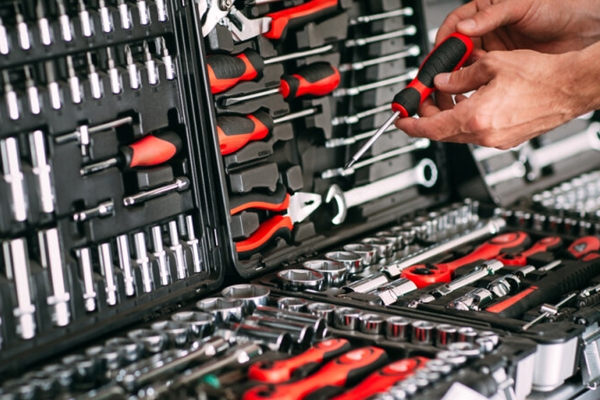While not the most glamorous items in your toolbox, automotive tools are essential to a well-maintained car. The right automotive tools can make the process of maintaining your vehicle more manageable and less time-consuming. While there are many types of automotive tools out there, we’re going to focus on five basic ones and what they do for you.
Wrenches
A wrench is an essential tool in any mechanic’s toolbox. They come in various shapes and sizes, from simple ratchet-action models that you can use with one hand to heavy-duty crescent wrenches that require both hands for use.
Each wrench has been designed for specific jobs like loosening or tightening bolts, nuts, or other components. However, they all have the special perks that make them worth having around:
1. Spanners
These wrenches come built with a large head so that you can fit them over hard-to-reach bolts with ease. Their design is to make a tight grip on their target, so they can turn it without slipping or sliding.
Spanners come in various sizes and shapes, from the most common 6-point types used for general jobs to the smaller 24-point versions used when accuracy is paramount.
2. Oil filter Wrench
An oil filter wrench function is to loosen and remove an automobile or truck’s oil filter. Its primary function is to provide a more consistent grip on the filter and increase torque, making it easier to twist the old filter. You use the handle of the wrench to turn and tighten it.
Other types of wrenches that you can find in shops like ToolsQuik include impact wrenches, torque wrenches, open-ended, and cordless ratchets.
Screw Drivers
We use screwdrivers to turn screws or bolts, and they come in various shapes and sizes. The most common type is the slotted screwdriver with its thin metal blade, which can fit into any slot in a screw head.
The blade has grooves cut into it so that when you push down on the handle, the blade will slide under the head of a screw and press against it evenly for turning.
Another modern version of the screwdriver is the Y-shaped driver. You insert into a slot in a screw head and pull up to turn it without forcing pressure down on one side. This design allows for more consistent turning power and less strain on your wrist than traditional slotted drivers can offer.
Pliers
Pliers are hand tools used to grip and turn objects. They come in many shapes and sizes. Pliers are usually made from metal or plastic. However, some can come from other materials like rubber or even wood.

The most common plier type is the flat-nose plier, which has two vertical jaws with a gap between them that opens when you squeeze the handles are together.
Flat-noses come in various sizes, but they all have one thing in common. One side has a wide mouth and a narrow jaw for holding objects of varying diameters or thicknesses.
Hammers
Hammers come in different shapes and sizes, depending on what they’re used for.
- There are claw hammers that have one flat end meant for pulling nails out of wood.
- Ball peen hammers with short heads that are heavier at one end than the other.
- Mallets have a rounded head made from hardwood like oak or maple, not to damage softer materials.
- Sledgehammers consist of a heavy steel head attached to a long handle, usually hardwood like hickory or ash.
- Carpenter’s hammers are lighter than sledgehammers, with a two-sided head to allow for more precise driving of nails.
Vice Grip
A vice grip is a type of tool used to hold or clamp objects firmly. The most common kind of vice grip has two jaws, one fixed and the other movable.
When you apply pressure to the movable jaw, it moves towards the fixed jaw, gripping any object in between with increasing force as you continue to press down on it.
Vice grips come in many shapes and sizes, depending on what they’re used for. Some have long handles that make them easier to use from a distance. In contrast, others are small enough to fit into tight spaces like engine bays or underneath cars.
Closing Remarks
Going with the cheapest tool for your automotive needs may be tempting, but many perks to investing in a more expensive option. For example, some tools can help you save time and money down the road by being easier on parts or providing better quality work overall.

